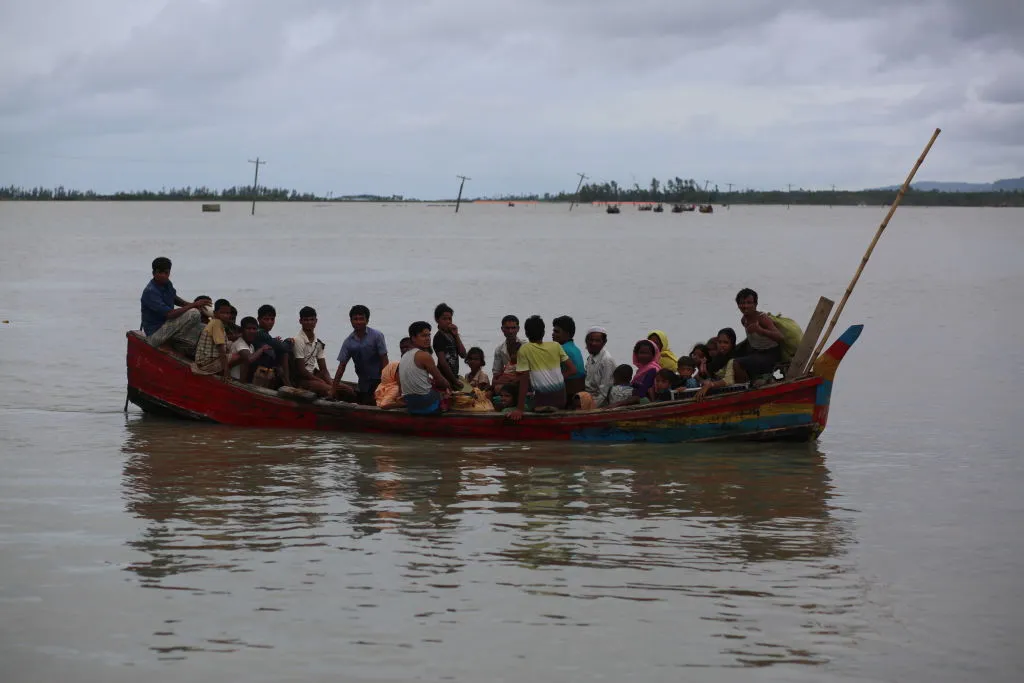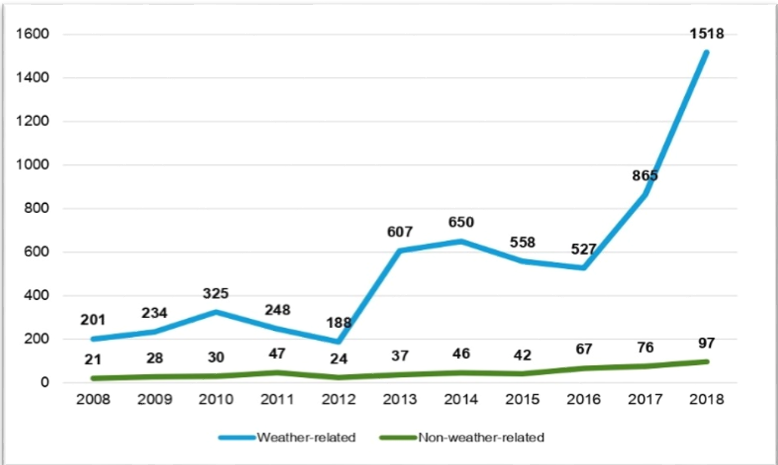
Climate-induced displacements have increased both in numbers and magnitude worldwide. According to the Internal Displacement Monitoring Centre’s (IDMC) report,
23.7 million people experienced displacements in 2021 as a result of cyclones and floods. Climate change has increased the severity of hazards such as heatwaves, droughts hurricanes, earthquakes, floods, and forest fires, as well as slow-onset changes including sea-level rise. The UN International Strategy for Disaster Reduction (UNISDR)
defines a hazard as a dangerous phenomenon, human activity, substance, or condition that could lead to injury, loss of life, property damage and so on.
The International Organisation on Migration (IOM) estimates that on a global scale, between 25 million and 1 billion people would be compelled to migrate from their homes because of climate change and environmental degradation by 2050. South Asia is no exception to it. Disasters cause most of the internal displacements occurring in South Asia every year, and in the year 2021, nearly 5.3 million disaster displacements were reported. The
Climate Action Network South Asia (CANSA) reports that approximately 45 million people in India alone, shall be compelled to migrate by 2050 due to climate disasters, with a threefold increase in current figures.
Despite such concerning figures, there is a lack of consensus on how to deal with climate-induced displacements. Often terms such as “environmental refugees”, “climate refugees”, “climate migrants” and “environmental migrants” are used interchangeably. Against this backdrop, this essay intends to analyse a) linkages between climate change/environmental degradation, and human migration and b) how international regimes interpret climate-induced displacements and protection mechanisms.
Who are the climate migrants?
IOM defines
climate migrants as “…persons or groups of persons who, predominantly for reasons of sudden or progressive changes in the environment that adversely affect their lives or living conditions, are obliged to leave their habitual homes, or choose to do so, either temporarily or permanently, and who move either within their country or abroad.” Contrary to large-scale mass cross-border (inter-country) migration, climate-induced displacements are generally small-scale and internal (within the boundaries of a country) by nature.
The Intergovernmental Panel on Climate Change (IPCC)
mentions how one of the greatest impacts of climate change could be on ‘human migration’. In most migration cases, it is challenging to distinguish environmental and climate change triggers from economic, political, reasons. Under this complex scenario, environmental and climate change factors are becoming more salient in determining how people migrate.
Vulnerabilities of women and children
Also, it is no surprise that the effects of climate change and vulnerabilities
disproportionately burden the most marginalised sections of our society—women and children. The United Nations asserts that around
80 percent of climate change displaces include women. The present share of women migrants in the Global International Migrant Stock oscillates between
48 percent and 52 percent, as they frequently experience ‘
triple discrimination’ given their positions as women, unprotected workers and migrants. The situation becomes even more precarious in developing countries like India, Bangladesh, Myanmar, and several small island nations in the Pacific Ocean. Women uprooted due to climate change become more vulnerable to violence, human trafficking, and armed conflicts. For instance, a
study by the Sierra Club (2018) revealed how women impacted by Cyclone Nargis in Myanmar witnessed “increased occurrences of sexual and domestic abuse, forced prostitution, and sex and labour trafficking”.
Debates on terminology
Article 1A (2) of the 1951 Refugee Convention mentions three prerequisites that qualify one as a refugee: One having a well-founded fear of facing persecution on grounds like religion, race, nationality, etc.; presently situated outside their country of origin; and thereby, not willing to avail of the protection in their country of origin. In this regard, a “climate refugee” must prove that they would be at risk of persecution if they are to return to their country of origin, and that too on grounds as highlighted by the Convention. A
briefing by the Overseas Development Institute (ODI) reveals how those who have been displaced
en masse are often erroneously labelled as “climate change refugees”. If that were the case, then theoretically, “climate refugees” would be able to travel across the borders to seek protection in another country. The situation is usually otherwise, and somewhat rather complex and precarious.
It is worth noting that the United Nations High Commissioner for Refugees (UNHCR) recognises such persons as ‘environmental migrants’ and
refuses to accord them a refugee status. Likewise, the United Nations Development Programme (UNDP) believes it is essential to realise opportunities that stand in connection to “migration in the context of climate change” if governments want to be serious regarding their commitments to the Paris Agreement, Sustainable Development Goals (SDGs) and the Sendai Framework for Disaster Risk Reduction (SFDRR). This linkage is further explored by a UNDP-ODI
report on complex relationships between human mobility and climate change.
Such descriptions imply a broad understanding of the concept of climate migration. It shows how such migration can be permanent or temporary, individual, or collective, due to slow-onset events or sudden-onset events, and/or in other complex forms. Oxfam
reports how climate-fuelled disasters have now emerged as the largest driver of internal displacements across the globe, with data from the IDMC showing a five-fold increase in the number of reported extreme weather disasters that displaced people over the last decade.
 Figure 1: Number of climate-related disasters every year that create internal displacements
Source: Oxfam Media Briefing
Figure 1: Number of climate-related disasters every year that create internal displacements
Source: Oxfam Media Briefing
The New York Declaration and its Global Compacts
The New York Declaration (2016) provided a starting point for the countries to commence with negotiations on the various aspects of international migration. It mandated the adoption of the Global Compact for Safe, Orderly and Regular Migration (GCM) in 2018– and for the first time, a comprehensive framework recognising the concept of climate change-induced migration within the broader concept of international migration was developed. The Declaration also paved the way for an adoption of a Global Compact on Refugees (GCR) in the same year, but an extension of refugee law to cater to the needs of those displaced by the forces of climate change does not really resolve this humanitarian concern.
The key
takeaways of the GCM show that it recognises slow onset environmental degradation, climate change impacts and natural disasters as factors that provide an impetus to contemporary migration. It also highlights the need for pumping in more investments towards research to tackle the challenges of environmental migration and rests on important climate change mitigation instruments like the
Paris Climate Agreement,
Sendai Framework for Disaster Risk Reduction, and the
United Nations Convention to Combat Desertification (UNCCD). Despite being the first migration-focused multilateral instrument, its soft law nature brings forth concerns of possible non-compliance by the states that are party to it.
The
Zero Draft of the GCM itself highlights how it sets out shared responsibilities of the states in commitment to the causes of migration– showing how the GCM relies on the countries having a sense of moral responsibility for the fulfilment of its goals and objectives.
Article 7 of the Compact’s Preamble also emphasises on how it upholds the sovereignty of all the states that are party to it– thus, showing how the GCM remains limited in its scope as a document that is technically non-binding and can be violated by those party to it.
COP27 and climate migration
The 2022 Conference of the Parties' (or COP27) summit was seen as a platform that would lend visibility to the concept of climate migration, especially in light of how a work programme for defining a Global Goal on Adaptation (GGA) towards identifying collective needs and solutions in light of the ongoing climate crisis that has already affected so many countries around the world, was established in the 2021 COP26 summit. In the past, COPs have spoken of climate-induced displacements and acknowledged its importance in instances like the adoption of the Cancun Adaptation Framework at COP16, and the creation of a Task Force on Displacement at COP21.
While policymakers met to discuss the several concerns of climate change at COP27, progress concerning any support for the climate migrants remain insufficient till date, resting on goodwill gestures instead.
While COP27 established a framework towards the attainment of the GGA (likely to be adopted in 2023 at COP28), its progress towards protecting and assisting climate migrants remains in a state of limbo. As highlighted in a
study by the ECDM, the key problem lies in how the Task Force on Displacement has projected climate-induced mobility as a “loss and damage” concern, in turn putting forth the idea that this kind of human mobility stands as a failed adoption strategy.
This emerges as a bottleneck with regard to any concrete action from being taken up on the issue of climate migrants and must be immediately redressed. While policymakers met to discuss the several concerns of climate change at COP27, progress concerning any support for the climate migrants remain insufficient till date, resting on goodwill gestures instead.
Situating India in current discourse
It is interesting to note how the G20 countries have not taken up the cause of climate migration, even when about
8.5 million people remained displaced by disasters in G20 member countries like the United States, Japan, India, China, and Indonesia.
Paragraph 40 of the G20 Bali Leaders’ Declaration talks about preventing irregular migration flows, the trafficking of migrants and holding such talks in the future G20 summits to come, but the term “climate migration” fails to make an appearance.
India seeks to play a significant role in the international efforts for climate action, and its commitment can be reflected in it being party to the UNFCCC
It is essential to form a coalition between the G20 countries and multilateral institutions like the United Nations Network on Migration (UNNM) that aims to build stronger synergies between the objectives of the Sendai Framework for Disaster Risk Reduction, Paris Agreement, Sustainable Development Goals, and the UN Framework Convention on Climate Change (UNFCCC).
India seeks to play a significant role in the international efforts for climate action, and its commitment can be reflected in it being party to the UNFCCC and its instruments–the Kyoto Protocol and the Paris Agreement. Its presidency could provide a platform for the G20 countries to work together in addressing the growing concerns of human mobility in forms of both migration and displacements. Also, knowledge gaps pertaining to human mobility because of climate change and environmental degradation can be addressed through intergovernmental dialogues to be held at the G20 platform under India’s Presidency.
The authors acknowledge the contribution of Soumi Biswas, Intern ORF, Kolkata chapter for research inputs.
The views expressed above belong to the author(s). ORF research and analyses now available on Telegram! Click here to access our curated content — blogs, longforms and interviews.



 Climate-induced displacements have increased both in numbers and magnitude worldwide. According to the Internal Displacement Monitoring Centre’s (IDMC) report,
Climate-induced displacements have increased both in numbers and magnitude worldwide. According to the Internal Displacement Monitoring Centre’s (IDMC) report, 
 PREV
PREV



